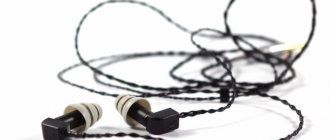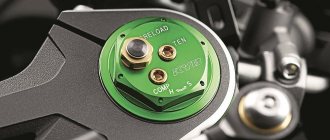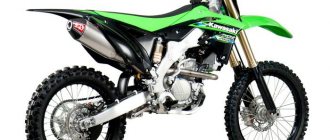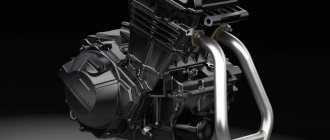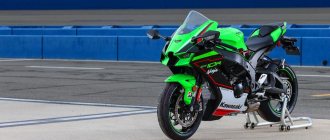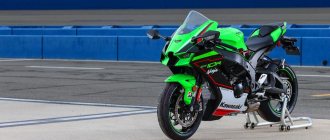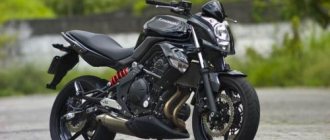The Japanese corporation Kawasaki is rightfully considered one of the largest industrial concerns in the world. The range of manufactured products includes robots, tractors, trains, weapons, helicopters and aircraft components. But rarely has any of our compatriots heard about Kawasaki trains, but everyone has heard about motorcycles. The company's division specializing in the production of motorcycles offers many models to its fans, but the most popular and best-selling all over the world is the Kawasaki Ninja 250. This bike will bring a lot of pleasure to both novice motorsports enthusiasts and those who cannot imagine life without speed. Motorcycle enthusiasts may recall the 1986 Ninja model, but the 250R is significantly different from its predecessor in appearance and technical parameters, thanks to which the designers of the Japanese company managed to create an inexpensive and at the same time productive sports bike.
A short excursion into history
The Kawasaki Ninja 250 is a motorcycle that looks like its more powerful “brothers” in its class. Despite the fact that the working volume of its engine is 248 cc. see, he looks dignified and with a little aggression. The first modifications of the Kawasaki Ninja 250 R were produced in 1986, after which this series became an exemplary series - most manufacturers began to focus on it, which began to produce road superbikes and touring-class motorcycles. The first modifications of this series were the GPZ and GPX models, which almost immediately after their release became one of the best-selling models on the motor market. After the success of the pilot models, the company's management decided to put this motorcycle into mass production. Having undergone many changes, in 2008 the 250R version became available to motorcyclists with subsequent updates to the appearance, engine power system and a new wheelset.
Kawasaki Ninja 250 – is it strong enough for an experienced rider?
At first it may seem that there is not enough “power”, but after driving several tens of kilometers, you understand that, in principle, this is quite enough.
The new Ninja 250 produces 32 horsepower, which is more than enough for beginners or insecure drivers, but the smooth delivery of torque and medium-length gears will quickly make you outgrow this motorcycle.
The power of this motorcycle is enough for smooth, but mobile movement around the city with economical fuel consumption, and you shouldn’t expect more from it.
Features of design and external execution
According to numerous reviews from Kawasaki Ninja 250 owners and all those who have ever seen this motorcycle (even in photos), the main style of the bike is quite aggressive, but complemented by smooth lines and somewhat rounded shapes. This “little ninja” design (as it is often called by the designers and developers of the Kawasaki Corporation) is facilitated by a special shape of the head light, made in the form of a dual headlight. Rear view mirrors with slight angularities, made of impact-resistant polymer, add visual aggression.
An important feature of the Kawasaki Ninja 250 R is its almost completely closed body and the main components are almost completely hidden behind a plastic fairing, which contains many metal elements. The presence of a similar fairing with additional sharp edges improves the aerodynamic characteristics of the Kawasaki Ninja 250. The fender and fork fairing are made in the same aggressive style. The rear half of the bike is slightly raised above the wheelbase and is made in a pointed design, giving the vehicle a more sporty and high-speed look. The seat is double, made in two levels, making the 250R look stylish and expensive. The 250 R muffler is quite large, decorated with a chrome-plated tip on the right, which externally gives the motorcycle even more power.
When developing this Kawasaki model, the designers provided an informative dashboard located under the fairing and miniature windshield. The panel consists of a speedometer and tachometer, made in analogue style, with additional indicators for low pressure, gasoline level, battery charge and air filter status. Depending on the preferences of the motorcyclist and the technical characteristics of the Kawasaki Ninja 250, it can be purchased in four basic colors - green, blue, red and black.
What do the owners say?
According to those who have ridden road motorcycles before, the bike leaves a positive impression. Naturally, the difference is felt immediately. This is also noticed by those who have previously ridden touring vehicles. People who have driven enduro before see the least difference. Yes, the difference between simple and touring enduro is insignificant.
According to many, a sportbike is one of the most contrasting motorcycles in relation to its model and class. Therefore, after it, on the one hand, it is interesting to ride such a vehicle, but on the other hand, it is very unusual. Therefore, no matter how experienced a person is in driving a sports class car, the owners of the KLE 250 Anhelo recommend driving this model carefully at first. According to them, it requires slightly different skills and reflexes.
Among the advantages, they also note how much the car costs. It is possible to purchase a car for only 100 thousand Russian rubles. This is not bad for a touring enduro. Based on almost any review, it is possible to conclude that this Kawasaki is perfectly suited for both urban and rural areas. But the positive qualities of this car are fully revealed only with the experience and skill of the rider.
Some say that compared to larger touring motorcycles, the fuel tank is a bit small. However, few people consider this a disadvantage, because it is obvious that with a large tank the car would lose the dynamic characteristics required for the touring enduro class.
In conclusion, it is worth noting that the Kawasaki KLE 250 Anhelo is the choice for the role of a motorcycle for long-distance travel. Suitable for trips of many kilometers. Of course, you will have to more or less stick to the roads in order to refuel on time.
Motorcycle engine and gearbox
The Kawasaki Ninja 250 owes its technical characteristics to a properly selected engine and a transmission designed specifically for it.
It is necessary to note the professionalism of Kawasaki specialists, who were able to create an engine-gearbox combination capable of satisfying most of the tasks set by motorcyclists. The main feature of the engine installed in the 250R is the ability to produce maximum torque, but at the same time reducing peak power characteristics. If you constantly use medium speeds, then the motorcycle can reach the required speed in a few seconds without much difficulty. Over the several years of production of the Kawasaki Ninja 250, the engine has been repeatedly upgraded in order to increase the reliability of the unit. As part of the improvements, enlarged cylinder heads, a reinforced piston group and slightly modified piston rings were installed. An important point that has significantly improved the performance of the Kawasaki Ninja 250 is the improvement of the fuel combustion chamber and the installation of a fuel injection system.
The Ninja 250 is equipped with a six-speed transmission, the gear ratios of which are selected in such a way as to provide maximum comfort when driving in the city and on the highway. Drive to the rear wheel is realized using a chain. This model uses a telescopic front fork and a Uni-Track rear fork (with five stages of adjustment). 17-inch wheels make the bike manageable and comfortable during operation, while they give it additional stability while driving both in city mode and when driving on highways.
Safety and convenience
First of all, the skills of a biker allow you to ensure proper safety; regardless of the type of road surface, you must feel the road. Before racing fast, you should definitely get used to the brakes and grip. The Ninja motorcycle was able to achieve maximum stability on the road thanks to the presence of high-quality rubber, which holds the road even with a serious inclination. The diameter of the wheels is 17 inches, the front tire is 110/70, the rear is thicker - 130/70.
After a few kilometers you will feel the brakes more accurately; both wheels are equipped with petal disc brakes, but with different diameters. Also, both brakes are equipped with a 2-piston caliper. But many people point out that the brakes are disadvantageous due to the fact that they do not have adjustable brake and clutch releases. A real Japanese sport should be equipped with such a system.
Specifications
The manufacturer should be given credit, since the technical characteristics of this model are selected in such a way that its owner receives maximum comfort, power and speed at an affordable price. In order to understand all the design features of the 250 R, it is worth considering in more detail its main technical parameters:
- Engine – two-cylinder, in-line four-stroke, 248 cc. see, with 4 valves per cylinder. With this model you can get 33 hp. In order to optimize the operation of the motor as much as possible, liquid cooling is installed on it, which allows the power unit to be returned to its original state in a minimum time;
- Fuel supply system - from 2008 to 2013 it was implemented on the basis of a 2x Keihin CVK30 carburetor, and from 2013 it was replaced by an injector;
- Transmission – six-speed reverse with final drive directly to the chain;
- Braking system - consists of two-piston calipers and single-petal discs with a diameter of 290 mm (front brakes) and 220 mm (rear brakes);
- Frame and suspension – the front fork is telescopic, the rear fork is Uni-Track with a lower linkage mount.
The Kawasaki Ninja 250 motorcycle is designed in such a way as to implement the solutions of faster and more powerful models in a fairly compact bike. This is confirmed by the ability to accelerate the motorcycle to 170 km/h. At the same time, it can reach a speed of 100 km/h in just 6 seconds - this is a fairly high indicator for motorcycles of this class.
The use of a fuel injection system made this bike quite economical - 3-4 liters per 100 km, depending on the riding style and travel mode. An 18-liter tank will be enough to travel 500-600 km without refueling.
Brief history of the model
2008 - the beginning of official production and sales of the Kawasaki Ninja 250R model. First generation. Model: Kawasaki Ninja 250R (all markets). Factory designation: EX250-K8F, EX250-J8F (North America).
2009 - no significant changes. Model: Kawasaki Ninja 250R (all markets). Factory designation: EX250-K9F, EX250-J9F (North America).
2010 - no significant changes. Model: Kawasaki Ninja 250R (all markets). Factory designation: EX250-KAF, EX250-JAF (North America).
2011 - no significant changes. Model: Kawasaki Ninja 250R (all markets). Factory designation: EX250-KBF, EX250-JBF (North America).
2012 - no significant changes. Model: Kawasaki Ninja 250R (all markets). Factory designation: EX250-KCF, EX250-JCF (North America).
2013 - the model receives many changes. Second generation. Carburetor models receive an injector, while fuel-injected versions receive an injector with dual throttle valves. The engine receives a new crankcase, pistons and aluminum cylinders, the compression ratio is reduced from 11.6 to 11.3. According to engineers, the engine has improved traction in the low and mid-speed zone, as well as increased top speed and reduced vibration. New cast frame. New suspension settings (the front fork and rear shock absorber have become softer). The 2-in-1 exhaust system improved traction characteristics, added a catalyst compliant with Euro-3 standards, and new materials made it more resistant to corrosion. The fuel tank was reduced to 17 liters (instead of 17.8 liters). The rear tire width has increased by 10 mm (from 130 to 140 mm). Versions with ABS appeared. Model: Kawasaki Ninja 250; Kawasaki Ninja 250 ABS (Japan, etc.). Factory designation: EX250-LDF, EX250-LDFA (ABS); EX25-MDFA (ABS).
2014 - no significant changes. Model: Kawasaki Ninja 250; Kawasaki Ninja 250 ABS (Japan, etc.). Factory designation: EX250-LEF, EX250-LEFA (ABS), EX250-LES, EX250-LESA (ABS); EX25-MEFA (ABS), EX250-MESA (ABS).
2015 - no significant changes. Model: Kawasaki Ninja 250; Kawasaki Ninja 250 ABS (Japan, etc.). Factory designation: EX250-LFF, EX250-LFFA (ABS); EX25-MFF.
2016 - no significant changes. Model: Kawasaki Ninja 250; Kawasaki Ninja 250 ABS (Japan, etc.). Factory designation: EX250-LGF, EX250-LGF (ABS); EX25-MGF (ABS).
2017 - no significant changes. Model: Kawasaki Ninja 250; Kawasaki Ninja 250 ABS (Japan, etc.). Factory designation: EX250-LHF; EX25-MHF.
2018 - the model receives further changes. Third generation. This model replaces the previous versions of the Ninja 250 and Ninja 300. The new version features increased power (39 hp), updated appearance, chassis and a 14 liter tank. Model: Kawasaki Ninja 250 / ABS (Japan). Factory designation: EX250PJF / EX250PJFA.
2019 - minor updates to meet environmental standards. Reduced maximum power from 39 to 37 hp. Model: Kawasaki Ninja 250 / ABS (Japan). Factory designation: EX250PKF / EX250PKFA.
2020 - no significant changes. Model: Kawasaki Ninja 250 ABS (Japan). Factory designation: EX250PLFA.
2021 - no significant changes. Model: Kawasaki Ninja 250 ABS (Japan). Factory designation: EX250PXXXX.
Reviews of the bike from owners and more
Many motorcycle enthusiasts are interested in real reviews from the owners of this model. If you turn to specialized forums and information portals, you can hear only positive impressions. Reviews of the Kawasaki Ninja 250 say that the motorcycle is great for beginner bikers, although many argue that even an experienced rider can have a lot of pleasant experiences on it. Separately, good acceleration is noted, taking into account the engine capacity of only 248 cc. see Among its features, experts and experienced bikers note relatively short gears, which require a little getting used to in order to confidently use them. Do not forget that despite all its technical characteristics, the motorcycle is inexpensive to maintain and repair, and this is a significant plus for the majority of Russian motorcycle enthusiasts.
Photo gallery
This motorcycle brought many modern riders into the sport and continues to this day. The low cost, outstanding characteristics of the motorcycle and its versatility in terms of the possibility of use, both in sports and in everyday life, help its owner determine his preferences. We present to your attention a small photo selection of the Kawasaki ninja 250R.
Service specifics
The Kawasaki Ninja 250, like many Japanese-made motorcycles, is not very demanding in terms of maintenance. An important point for its long-term operation is timely maintenance and the use of high-quality consumables. It is not recommended to refuel your bike at gas stations that offer cheap and not always high-quality fuel, as this can lead to failure of the injector, and in some cases, the piston group. To ensure maximum service life, it makes sense to diagnose the motorcycle at least once every six months using specialized diagnostic equipment. The oil used for the 250R four-stroke engine is recommended to use only new (do not save and buy used motor oil) semi-synthetic 5W-40 or 10W40 from well-known manufacturers.
Appearance
Similar in places to enduro, but the gas tank is raised higher, and the fender on the middle wheel better protects the tire. The frame shape is more curved. Kawasaki KLE 250 Anhelo looks good in turquoise color. At the same time, its parts and exhaust pipe look great in a metallic color, but not chrome.
Judging by the videos and photos from previous years, the new KLE 250 Anhelo looks great. Of course, a used model will be inferior in appearance if it has been used for a long time and not in the most competent manner. However, if the owner has taken good care of the bike, then it is possible that no difference will be noticeable, and the equipment will look like new.
The cost of the “little ninja”
Initially, Kawasaki Ninja 250 R was created as a motorcycle whose cost would not be too high. We can safely say that this was a success - you can buy this model from official dealers of the company in Russia at a price of 2500-3500 USD. (depending on the basic configuration). If you buy it on the secondary market, then the cost ranges from 1000-2000 USD. (depending on year of manufacture and condition).
Due to the fact that the production of the first models of this sport bike started in 2008, there are no problems with spare parts, components, assemblies and consumables - they are presented in a wide range in many specialized stores and on the Internet. Moreover, the price of components is low, so if the equipment breaks down, the owner will not have any difficulties.
Specifications
| Maximum engine power: | 32 HP |
| Torque: | 22 Nm |
| Working volume: | 249 cm3 |
| Motor type (cylinder arrangement, number of strokes): | In-line, 2 cylinders, 8 valves |
| Number of cylinders: | 2 |
| Number of valves: | |
| Intake type (Injector / Carburetor): | |
| Bore and stroke: | |
| Starting system (Electric starter, kick starter): | |
| Maximum speed in km/h: | 180 km/h |
| Cooling system: | Liquid |
| Transmission (gearbox): | 6 |
| Clutch (Dry / Wet): | |
| Drive unit: | Chain |
| Chassis | |
| Suspension (front/rear travel): | |
| Brakes (Front/Rear): | |
| Wheels / Tires / Rubber: | |
| Dimensions and weight | |
| Dimensions (Length / Width): | |
| Seat height: | |
| Ground clearance: | |
| Curb weight: | |
| Wheelbase: | 1390 mm |
| Weight: | 151 kg |
| Fuel tank capacity: | 18 l. |
| Battery capacity: | |
| Year of release: | |
| Country of Origin: |
Comfort
This Kawasaki motorcycle is not the best option for traveling as a couple. However, this cannot be said to be physically impossible. The main thing is to be careful and not accelerate to dangerous speeds. And those on different parts of the route can vary greatly. Somewhere even 50 km/h will pose a threat, if not for the driver, then for the passenger.
The car handles well and is therefore comfortable in an urban environment. Due to its light weight, the bike is unlikely to fall over in yards and traffic jams. Unless the speed will be very low. The bike is also comfortable off-road, but still, this is not a cross-country motorcycle, which should not be forgotten.


